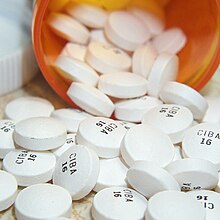| Regulation of therapeutic goods in the United States |
|---|
 |
|
Prescription drugs Over-the-counter drugs |

The Food and Drug Administration's (FDA) New Drug Application (NDA) is the vehicle in the United States through which drug sponsors formally propose that the FDA approve a new pharmaceutical for sale and marketing.[1][2] Some 30% or less of initial drug candidates proceed through the entire multi-year process of drug development, concluding with an approved NDA, if successful.[1]
The goals of the NDA are to provide enough information to permit FDA reviewers to establish the complete history of the candidate drug.[3] Among facts needed for the application are:[2]
- Patent and manufacturing information
- Drug safety and specific effectiveness for its proposed use(s) when used as directed
- Reports on the design, compliance, and conclusions of completed clinical trials by the Institutional Review Board
- Drug susceptibility to abuse
- Proposed labeling (package insert) and directions for use
Exceptions to this process include voter driven initiatives for medical marijuana[4] in certain states.
- ^ a b "The Drug Development Process". U.S. Food and Drug Administration. January 4, 2018. Retrieved May 1, 2018.
- ^ a b "The Drug Development Process. Step 4: FDA Drug Review". U.S. Food and Drug Administration. January 4, 2018. Retrieved May 1, 2018.
- ^ Gad, Shayne Cox (2008). Pharmaceutical Manufacturing Handbook: Production and Processes. John Wiley & Sons. ISBN 9780470259801.
- ^ Commissioner, Office of the. "Public Health Focus - FDA and Marijuana". www.fda.gov. Archived from the original on April 28, 2018. Retrieved April 30, 2018.
